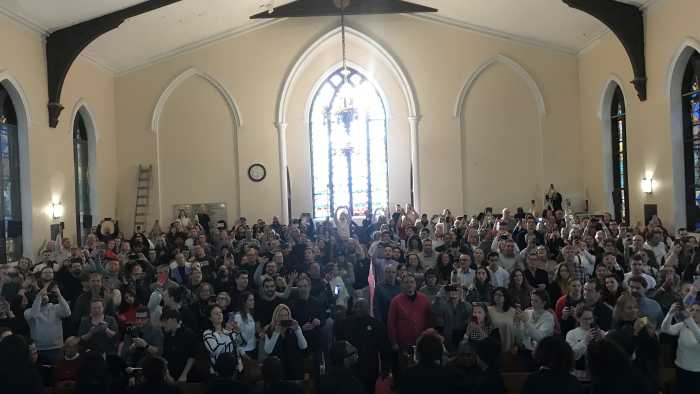By Ronda Kaysen
The Drawing Center is considering a new home in the South Street Seaport, its first public step since leaving the World Trade Center, adding a new twist to the story of the redevelopment of Lower Manhattan.
The Soho-based museum has been in discussions with city and redevelopment officials about building a new two-story, 40,000 sq. ft. museum in a building previously occupied by the Fulton Fish Market, which moved to a new facility in the South Bronx in November. The museum has set its sights on the New Market building, near the Pier 17 mall at South St.
“We’re headed toward a good conclusion here. It’s going to be a huge effort to get this to happen,” said Drawing Center president George Negroponte in a telephone interview with Downtown Express.
The 29-year-old museum has been looking for a new home since it bowed out of the Trade Center redevelopment last summer after sustaining fierce criticism from some 9/11 family members wary of a museum adjacent to the memorial. In November the Lower Manhattan Development Corporation, the agency steering the redevelopment, allocated the museum $10 million to help them relocate.
The aging New Market building, a city-owned property just outside of the neighborhood’s historic district, juts into the East River. Next to Pier 17, a General Growth property, the New Market looks out across the river to DUMBO, a Brooklyn neighborhood with a growing arts community. “It would be symbolic and ultimately beautiful that it would be facing what we think is the arts community of New York,” said Negroponte.
Concept plans of the $45-million building show a two-story structure with a rippled, maritime rooftop and slatted windows. The ground floor is set back, creating a large open space outside. The first floor of the building would likely include extensive public space, such as a café, bookstore, educational programs and a public reception area. “It’s a building about light and water,” said Claire Weisz of Weisz + Yoes, the Drawing Center’s architectural consultant, sitting in her Centre St. office Wednesday.
The Drawing Center has remained largely silent since it withdrew from the W.T.C. last summer, spending its energy looking for an alternate site. It considered several city-owned and private properties in the neighborhood, including Fiterman Hall on the northern edge of the Trade Center site. Fiterman, a Borough of Manhattan Community College property, is supposed to be demolished later this year because of damage it sustained on 9/11. The new building there would have been a near perfect fit for the Drawing Center, said Weisz.
Ultimately, “We could not fit into their plans in the manner that we wished,” said Negroponte. The Drawing Center shifted its focus to building a structure from the ground up.
“The opportunity for any institution to have a free-standing building cannot be underestimated,” said Weisz.
The shift east from the Trade Center bodes well for the L.M.D.C., which has a special interest in the Seaport. The corporation set aside $150 million to redevelop the East River waterfront and $38 million to revitalize the tawdry Fulton St. corridor, which originates at the Seaport and will run through the W.T.C. site.
The Seaport “would be an ideal location for an institution that will bring culture and energy to the neighborhood,” L.M.D.C. president Stefan Pryor told Downtown Express. The Seaport is in the “top tier” of possible locations for the museum, he said. “It makes it very attractive for the L.M.D.C.”
Although the Drawing Center found the Seaport on its own, the fact that L.M.D.C. had a personal stake in the neighborhood did not go unnoticed. “It is a priority site for L.M.D.C. and for the city and for the mayor. We’ve taken that into consideration,” said Negroponte.
When the Fish Market moved to a new facility in the South Bronx in November, it set in motion a long-awaited redevelopment process. General Growth Properties, which operates the Seaport Mall, holds the lease for two Fish Market properties—the Tin Building and the Market Stalls on South St. The company is expected to exercise its right to develop the properties in the next six months. How General Growth proceeds will determine much of what happens in the neighborhood.
General Growth’s master plan for the area may have an arts component and will definitely include the New Market building, Michael Piazzola, vice president of the Seaport Market Place, a division of General Growth, told Downtown Express last month. Drawing Center and General Growth officials have discussed the possibility of building a museum at the Seaport several times in recent weeks. Piazzola said he has spoken to the city about including New Market in its plan and city officials are waiting to see what General Growth ends up proposing.
General Growth, one of the largest real estate investment trusts in the country, is considering a cultural institution and building a hotel with residential units, said Cheri Fein, a General Growth spokesperson.
Discussions between the museum and the firm have been promising, said Negroponte. “We’ve had several discussions, they’ve been good discussions. They take us seriously. They’re well aware of the role we played in the World Trade Center.”
General Growth acquired the Seaport properties more than a year ago when it bought the Rouse Company. Last year, it hired Beyer Blinder Belle, a large architectural and planning firm known for its preservation work, to help design a proposal to present to the city, which owns the properties. Although the company has been tightlipped in recent months, the air has been rife with speculation.
“The big elephant in the room is General Growth,” said Gary Fagin, a 20-year Seaport resident and a director of the Seaport Community Coalition, which helped rezone the neighborhood in 2003. “The word has always been that they have right of first refusal. There seems to be some question of what the extent of that is.”
General Growth’s two Fish Market properties — the Tin Building and the Market Stalls — are landmark properties in a historic district. Whatever General Growth decides, it must vet its plans with the city’s Economic Development Corporation, which oversees the city-owned property. There are deed restrictions to the lease, according to the E.D.C. and any plans that deviate from the restrictions or do not comply with the zoning restrictions would need city approval. “The city’s the landlord,” said E.D.C. spokesperson Janel Patterson. “They [General Growth] have an option on it, but it’s still city property.”
Last month, General Growth sold off about three-dozen office and industrial buildings in Maryland it inherited from Rouse. Rumors have been circulating that the company might also unload part of its Seaport holdings. Fein insists the speculation is “not accurate at this time.”
Whatever comes of the Seaport, it is clear the neighborhood is on the brink of a major transformation. The Fulton Fish Market’s November departure beckoned a new era for the landmark district.
Historic Front Street, a new development on Front St. between Beekman St. and Peck Slip, recently leased five of its 15 retail properties. A restaurant, wine bar, pizzeria and upscale deli are all expected to open on the block by early spring. A Pita Grill, a bakery and a florist will likely sign leases by the end of the month, according to Robert Frischman, president of JDF Realty, the leasing agent.
“The Fish Market was always the big question mark,” said Frischman. “Now that it’s left a whole new dynamic has been unleashed.”
Frischman expects to lease the remaining eight storefronts by summer.
The change is fraught with anxiety for some longtime residents who worked first to landmark the neighborhood in the late ‘70s and then rezone it two years ago. Some worry the neighborhood could go the way of Soho, an artist’s enclave that has withered into an overpriced shell of itself with inaccessible flagship stores and luxury lofts. The other extreme—the Meatpacking District’s infamous late-night, velvet-rope club scene—is “the worst possible scenario,” said Fagin.
But a notable museum that has received international attention because of its role in the Trade Center might put some of those concerns to rest. The Drawing Center is a “major, major player Downtown,” said Fagin. “The fact that they won the ground zero spot is pretty extraordinary, it shows the extent of their stature. They’re well positioned Downtown to do good things.”
Ronda@DowntownExpress.com
WWW Downtown Express






































